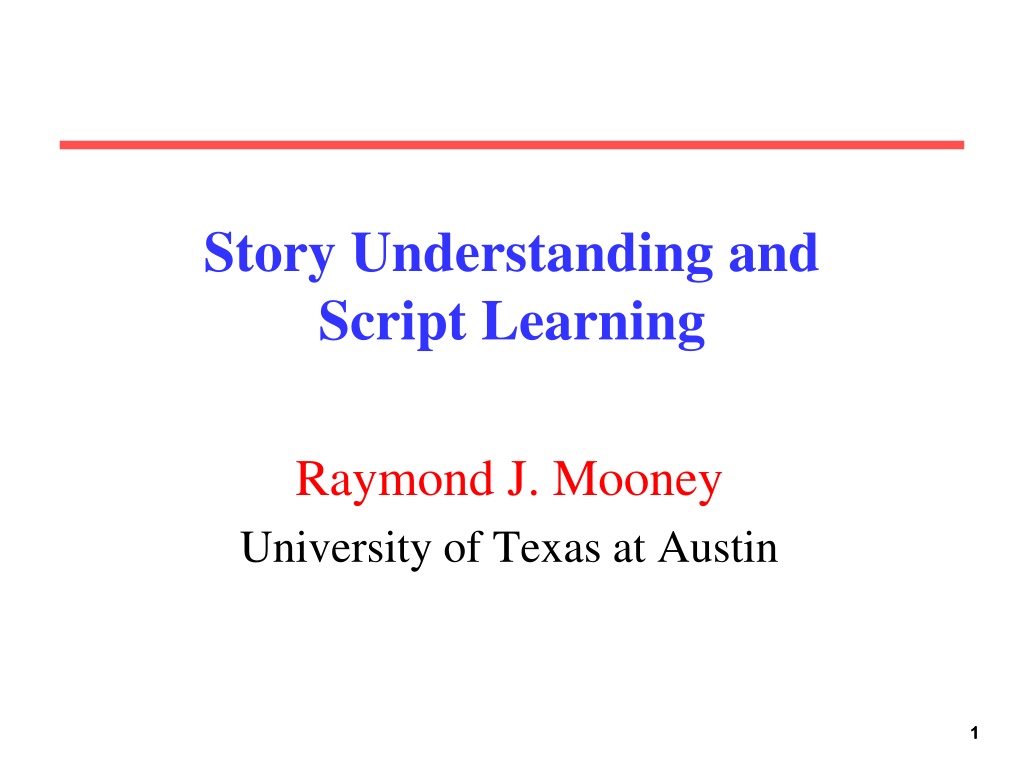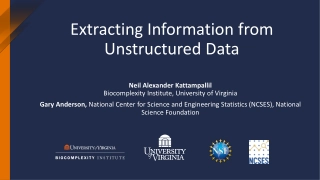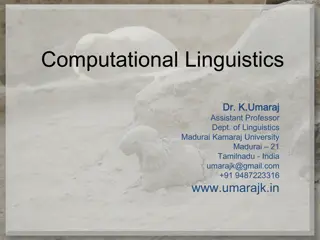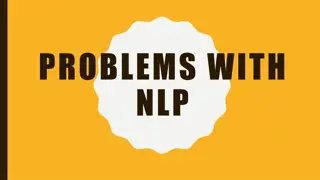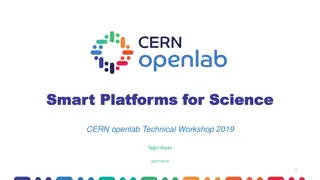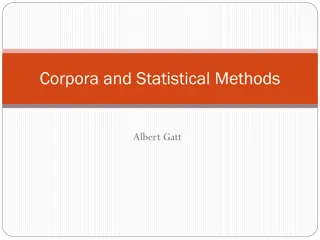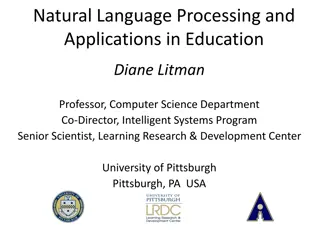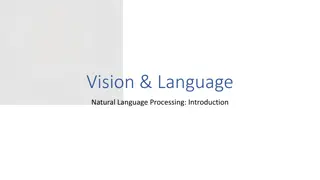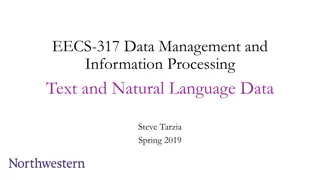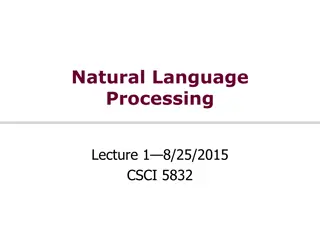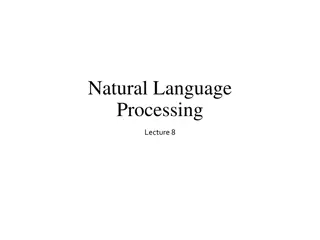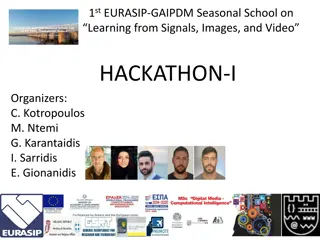Evolution of Natural Language Processing in AI Research
The evolution of Natural Language Processing in AI research from the 70s and 80s focused on knowledge representation, complex inference, story understanding, and script learning. Concepts like Conceptual Dependency and Scripts were developed to represent meaning and improve text understanding. However, challenges such as encoding complex verbs and object representation posed limitations in semantic parsing.
Download Presentation

Please find below an Image/Link to download the presentation.
The content on the website is provided AS IS for your information and personal use only. It may not be sold, licensed, or shared on other websites without obtaining consent from the author. Download presentation by click this link. If you encounter any issues during the download, it is possible that the publisher has removed the file from their server.
E N D
Presentation Transcript
Story Understanding and Script Learning Raymond J. Mooney University of Texas at Austin 1 1 1
AINLP in the 70s and early 80s Focused on knowledge representation and complex inference. Focused on story understanding and interpreting characters goals and plans (Charniak, Schank et al.) Focused on dialog understanding that inferred participants goals and plans. Required extensive manual symbolic knowledge engineering. Only worked on a small number of specially concocted illustrative examples. Brittle and difficult to generalize to robust, reliable performance on unseen examples.
Conceptual Dependency Semantic representation developed by Schank in his UT thesis in 1969. Represents meaning using a frame-like representation based on a set of semantic primitives with slots for semantic roles. PTRANS: Physical transfer, e.g. go, drive ATRANS: Abstract transfer of ownership, e.g. give, sell. MTRANS: Mental transfer of information, e.g. tell, email. INGEST: Take into the body, e.g. eat, drink.
Conceptual Dependency Example John sold a Prius to Mary for $20K. (ATRANS (AGENT John) (OBJECT (CAR (MODEL Prius) (FROM John) (TO Mary)) (ATRANS (AGENT Mary) (OBJECT (MONEY (AMOUNT 20000) (UNITS US-dollars)) (FROM Mary) (TO John))
Conceptual Dependency Motivation and Issues Motivation: Reduce sentences to canonical form that supports question answering without inference. Did Mary buy a car from John? Did Mary give John money? Issues: Correct and comprehensive set of primitives is unclear Hard to encode complex verbs like bet No guidance in representing objects. Makes semantic parsing difficult.
Scripts Knowledge of stereotypical sequences of actions used to improve text understanding (Schank & Abelson, 1977). Used to improve text understanding by enabling: Inference of unstated but implicit events Resolution of syntactic and semantic ambiguities Resolution of co-references 6
Restaurant Script (Ptrans (agent (Person X)) (object (Person X)) (to (restaurant Y)) (Ptrans (agent (Person Z)) (object (Menu U)) (from (Person Z)) (to (Person X)) (Mtrans (agent (Person X)) (to (Person Z)) (object (Goal (agent (Person X)) (object (Ingest (agent (Person X)) (object (Food W)))))) : (Ptrans (agent (Person Z)) (object (Food W)) (from (Person Z)) (to (Person X))) : (Atrans (agent (Person X)) (object (Money V)) (to (Person Z))) : 7
Drawing Inferences John drove to Olive Garden. He ordered lasagna. He left a big tip and went home. What did John eat? Answer is never explicitly stated in the text Human readers naturally make such inferences when reading and later cannot even remember what was stated vs. inferred (Brewer & Nakamura, 1984). 8
Resolving Ambiguities John was really hungry so he went to his favorite rib joint. He ordered a rack Scripts can potentially provide context to resolve many types of ambiguities. 9
Resolving Co-References Mary walked into the hotel restaurant. The waitress brought the breakfast menu. She ordered a full stack of pancakes .. Knowledge of script roles can provide crucial evidence to aid co-reference decisions. 10
Manually Written Scripts SAM (Script Applier Mechanism) was the first story-understanding system to use scripts (Cullingford, 1978). FRUMP (Fast Reading, Understanding and Memory Program) was a follow-up system that used less detailed sketchy scripts to process UPI newswire articles and extract info about natural disasters, crimes, terrorist events, etc. (DeJong, 1979). 11
Early Script Learning My Ph.D. thesis research involved learning scripts (Mooney & DeJong, 1985). Used hand-coded symbolic knowledge to deeply understand short, concocted stories by understanding the plans and goals of the characters. GENESIS learned new plan schemata (e.g. kidnapping) from a single example using explanation-based learning to improve its future understanding. 12
GENESIS Trace Inititial Schema Learning Input: Fred is Mary's father and is a millionaire. John approached Mary and pointed a gun at her. She was wearing blue jeans. He told her if she did not get in his car then he would shoot her. He drove her to his hotel and locked her in his room. John called Fred and told him John was holding Mary captive. John told Fred if Fred gave him 250000 dollars at Trenos then John would release Mary. Fred paid him the ransom and the kidnapper released Mary. Valerie is Fred's wife and he told her that someone had kidnapped Mary. Thematic goal achieved: John is happy that John has the $250000. Explanation suitable for generalization. Pruning...Generalizing...Packaging... Creating New Schema: (CaptureBargain ?x55 ?a34 ?b9 ?c4 ?r5 ?y5 ?l11) ?b9 is a person. ?c4 is a location. ?r5 is a room. ?c4 is in ?r5. ?x55 is a character. ?b9 is free. ?x55 captures ?b9 and locks him/her in ?r5. ?a34 is a character. ?x55 contacts ?a34 and tells it that ?b9 is ?x55's captive. ?y5 is a valuable. ?x55 wants to have ?y5 more than it wants ?b9 to be ?x55's captive. ?a34 has a positive relationship with ?b9. ?a34 has ?y5. ?x55 and ?a34 carry out a bargain in which ?x55 releases ?b9 and ?a34 gives ?x55 ?y5 at ?l11. Unknown word 'ransom' refers to ?y5 in CaptureBargain Unknown word 'kidnapper' refers to ?x55 in CaptureBargain Having: ?x55 captured ?b9. suggest CaptureBargain Having: ?x55 contacted ?a34 and told it that ?b9 was ?x55's captive. suggest CaptureBargain Having: ?x55 and ?a34 carried out a bargain in which ?x55 released ?b9 and ?a34 gave ?x55 ?y5 at ?l11. suggest CaptureBargain Unknown word '?x55 kidnap ?b9' refers to CaptureBargain 13
GENESIS Trace Question Answering Ready for questions: >Summarize Mary was free. John captured Mary and locked her in a room. John contacted Fred and told him that Mary was John's captive. John wanted to have $250000 more than he wanted Mary to be John's captive. Fred had a positive relationship with Mary. Fred had the $250000. John and Fred carried out a bargain in which John released Mary and Fred gave John the $250000 at Trenos. >Why did John approach Mary? So John could aim the gun at Mary. >Why did John aim the gun at Mary? So John could threaten to shoot Mary with the gun unless Mary went from John in to the car. >Why did Mary get into the car? Because Mary wanted not to be shot and because Mary believed that if Mary did not go from John into the car then John would shoot Mary with the gun. >Why did John threaten to shoot Mary unless she got in the car? So John could drive Mary to the hotel in the car. >Why did John drive Mary to the hotel? So John could move Mary from the hotel into the room. 15
GENESIS Trace Question Answering (Cont.) >Why did John move Mary into the room? So John could confine Mary in the room. >Why did John confine Mary in the room? So John could call Fred and could tell him that Mary was John's captive and so John and Fred could carry out a bargain in which John released Mary and Fred gave John the $250000 at Trenos. >Why did John tell Fred that John was holding Mary captive? So John and Fred could carry out a bargain in which John released Mary and Fred gave John the $250000 at Trenos. >Why did Fred give John the money? Because Fred believed that if Fred gave John the $250000 at Trenos then John would release Mary and because Fred wanted Mary to be free more than he wanted to have the $250000. >Why did Fred have $250000? Because Fred had millions of dollars. >Why did Fred believe that John was holding Mary captive? Because John called Fred and told him that Mary was John's captive. 16
GENESIS Trace Question Answering (Cont.) >Why did Fred want Mary free? Because Fred was Mary's father. >Why did John release Mary? Because John wanted to have the $250000 more than he wanted Mary to be John's captive and because John believed that if John released Mary then Fred would give John the $250000 at Trenos. 17
GENESIS Trace Using the Learned Schema Input: Ted is Alice's husband. He won 100000 dollars in the lottery. Bob imprisoned Alice in his basement. Bob got 75000 dollars and released Alice. Thematic goal achieved: Ted is happy that Ted has the $100000. Thematic goal achieved: Bob is happy that Bob has the $75000. Ready for questions: >Summarize Alice was free. Bob captured Alice and locked her in a basement. Bob contacted Ted and told him that Alice was Bob's captive. Bob wanted to have $75000 more than he wanted Alice to be Bob's captive. Ted had a positive relationship with Alice. Ted had the $75000. Bob and Ted carried out a bargain in which Bob released Alice and Ted gave Bob the $75000. >Why did Bob lock Alice in his basement? So Bob could contact Ted and could tell him that Alice was Bob's captive and so Bob and Ted could carry out a bargain in which Bob released Alice and Ted gave Bob the $75000. >Why did Bob release Alice? Because Bob wanted to have the $75000 more than he wanted Alice to be Bob's captive and because Bob believed that if Bob released Alice then Ted would give Bob the $75000. 18
GENESIS Trace Question Answering (Cont.) >How did Bob get the money? Bob kidnapped Alice. >Who gave Bob the money? Ted gave Bob the $75000. >Why did Ted give him the money? Because Ted believed that if Ted gave Bob the $75000 then Bob would release Alice and because Ted wanted Alice to be free more than he wanted to have the $75000. >Why did Ted want Alice free? Because Ted was Alice's husband. >Why did Ted believe that Bob was holding Alice captive? Because Bob contacted Ted and told him that Alice was Bob's captive. 19
Resurrection: Statistical Script Learning Script learning was finally revived after the statistical NLP revolution by Chambers and Jurafsky (2008). After dependency parsing, and co-reference preprocessing, they learned probabilistic models for narrative chains : Knowledge of how a fixed protagonist serves as a particular argument of an ordered sequence of verbs in a text. 20
Background: Statistical Script Learning Millions of Documents NLP Pipeline Syntax Coreference Millions of Event Sequences Train a Statistical Model 2 1
Background: Statistical Script Inference NLP Pipeline Syntax Coreference Single Event Sequence New Test Document Inferred Probable Events Query Trained Statistical Model 22
LSTM LSTMs have recently demonstrated impressive performance on several NLP tasks: Machine Translation (Sutskever et al., NIPS-14) Image to text description (several, CVPR-15) Video to text description (Venugopalan et al., NAACL-15) We apply them to Statistical Script Learning: Model sequences of events. Infer new events by argmax-ing
LSTM Scripts Build LSTM Models of Event Sequences. Break events up into event components. Train LSTM to predict sequences of components. At each timestep, input either a verb, preposition, or verbal argument. Learn to predict component at next timestep.
LSTM Script Example Jim sat down. He ordered a hamburger. [Parse, Coreference] sit_down(jim) ; order(he, hamburger) sit_down [verb] jim [subj, ent1] [dobj] order [verb] he [subj, ent1] hamburger [dobj]
LSTM Script Example Learned Output: Next Event Component </S> jim order he hamburger ` ` ` ` ` ` ` ` ` ` ` ` sit_down Input: Verbs with Nouns jim order he hamburger
LSTM Script Example ` ` ` ` ` ` ` ` ` ` ` ` ` ` ` ` ` ` sit_down [verb] jim [subj] [dobj] order [verb] he [subj] hamburger [dobj] Input: Verbs with Nouns, Positional Info
LSTM Script Example ` ` ` ` ` ` ` ` ` ` ` ` ` ` ` ` ` ` ` ` ` ` ` ` e1 e1 SINGLETON sit_down jim order he hamburger Input: Verbs with Nouns, Positional Info, and Coref Info
LSTM Script Model At timestep t: Raw inputs Learned embeddings LSTM units Predictions of next component.
Events in LSTM Model Events actually have 5 components: Verb Subject Direct Object Prepositional Object Preposition To infer an event, perform a 5-step beam search to optimize joint probability of components.
Experimental Evaluation Train on English Wikipedia. Run Stanford Parser, Coref; extract sequences of events. Train LSTM using Batch Stochastic Gradient Descent with Momentum. Minimize cross-entropy loss of predictions. Backpropagate error through layers and through time.
Narrative Cloze Evaluation Narrative cloze: given an unseen document, hold out an event and try to guess it, given the arguments and other events in the document. Recall at k: How often is the right answer in the top k guesses? (Jans et al. 2012) We evaluate on 10,000 randomly selected held- out events from a test set. 32
Systems Evaluated Unigram: Always guess most common event. Bigram: Variation of Pichotta & Mooney (2014) Uses event co-occurrence counts. Previosuly best-published system on task. LSTM: LSTM script system. 33
Results: Predicting Verbs & Coreference Info Unigram 0.101 Bigram 0.124 LSTM 0.152 0 0.05 0.1 0.15 0.2 Recall at 25 for inferring Verbs & Coref info 34
Results: Predicting Verbs & Nouns Unigram 0.025 Bigram 0.037 LSTM 0.061 0 0.02 0.04 0.06 0.08 Recall at 25 for inferring Verbs & Nouns 35
Human Evaluations Solicit judgments on individual inferences on Amazon Mechanical Turk. Have annotators rate inferences from 1-5 (or mark Nonsense, scored 0). More interpretable. 36
Results: Crowdsourced Eval 0.9 Random 2.9 Bigram 3.7 LSTM 0 1 2 3 4 37
Generating Stories Can use trained models to generate stories : Start with <S> beginning-of-sequence pseudo- event. Sample from distribution of initial event components (verbs first). Take sample as first-step input, sample from distribution of next components (subjects). Continue until </S> end-of-sequence token.
Generated Story Generated event tuples English Descriptions (bear, ., ., kingdom, into) (attend, she, brown, graduation, after) (earn, she, master, university, from) (admit, ., she, university, to) (receive,she,bachelor,university,from) (involve, ., she, production, in) (represent, she, company, ., .) Born into a kingdom, she attended Brown after graduation She earned her Masters from the University She was admitted to a University She had received a bachelors from a University She was involved in the production She represented the company. 39
Event Sequence Inference NLP Pipeline Syntax Coreference Single Event Sequence New Test Document Inferred Probable Events Query Trained Statistical Model 40
Event Sequence Inference Single Event Sequence New Test Document Inferred Probable Events Query Trained Statistical Model 41
Event Sequence Inference Single Text Sequence New Test Document Inferred Probable Events Query Trained Statistical Model 42
Event Sequence Inference Single Text Sequence New Test Document Inferred Probable Text Query Trained Statistical Model 43
Event Sequence Inference Single Text Sequence New Test Document Parse Events from Text Inferred Probable Text Query Trained Statistical Model 44
Event Sequence Inference Single Text Sequence New Test Document What if we use raw text as our event representation? Parse Events from Text Inferred Probable Text Query Trained Statistical Model 45
Sentence-Level Neural Language Models Skip-Thought Vectors (Kiros et al., NIPS 2015) Use LSTMs to encode whole sentences into lower- dimensional vectors. Vectors trained to predict previous and next sentences. How well can such sentence-level language models infer events? 46
LSTM Event System (Pichotta & Mooney, AAAI 2016) Predict an event from a sequence of events. jumped(jim, from plane); opened(he, parachute) LSTM landed(jim, on ground) Optionally use another LSTM to translate event to text LSTM Jim landed on the ground. 47
LSTM Text System (Pichotta & Mooney, ACL 2016) Predict text from text. Jim jumped from the plane and opened his parachute. [Kiros et al. 2015] LSTM Jim landed on the ground. Parser landed(jim, on ground) 48
Predicting Events: Evaluation Narrative Cloze [Chambers & Jurafsky 2008]: Hold out an event from a document, judge systems ability to infer it. Accuracy: What percentage of the time does the top inference exactly match the gold standard answer? Partial credit: What is the average percentage of the components of the top inference that match the gold standard? 49
Predicting Events: Systems Most Common: Always guess the most common event. e1 -> e2: events to events. t1 -> t2 -> e2: text to text to events. 50
